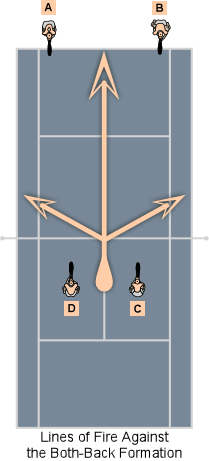November 2006 Article Wild Cards Archives:
Tennis Server
|

 |
by Kathy Krajco Operation Doubles
Everyone says that the way to win doubles is by attacking the net. But are
you one of those teams who often loses the point when you do? If so, and if
your strokes are good enough, you are probably just making a strategic
error, one you can eliminate almost as soon as you understand it.
Usually when you are in the Both-Up Formation, the opposition is in the
Both-Back Formation, so that's the situation we'll look at. In the end,
you'll see how this applies to volleys you hit toward the baseliner in the
Up-and-Back Formation, too.
Against the Both-Back Formation, the geometry is simple. You have two
tactics to choose from on every shot:
The diagram at the right illustrates:
You have three main lines of fire against the Both-Back Formation. Your
finishing shots are angled overheads and volleys to either side. You should
go for a finishing shot whenever you can, but hitting winners against the
Both-Back Formation is harder than it looks.
Why? Because your opponents are both baseliners, and baseliners have a good
angle of pursuit on your angle volleys to the alleys. Despite appearances,
they can often reach these shots, especially if they play shallow-on or
inside the baseline.
Result? You're dead. Because your shot is a short shot, so that opposing
baseliner hits from close range with a choice of no less than five lethal
returns:
If your team shifts to guard against one of them, you just open up another.
Therefore, your side-angle shots in the diagram must be winners. Don't
attempt a finishing shot if the opponent on that side is in a position to
make the get.
I think every author of a book on doubles has emphasized the previous
statement in one form or another. Yet both-up players often underestimate
how much ground baseliners can cover. Consequently, both-up players either
attempt finishing shots when they shouldn't, or they fail to volley
finishing shots smartly and sharply enough. The result? Disaster.
An angle volley to the baseliner's alley is even more dangerous when the
opposition is in the Up-and-Back Formation. That's because the baseliner in
this formation can position wider than the baseliners in the Both-Back
Formation. Therefore, he or she is even more likely to reach and return your
shot.
And so, when you have no clear shot at this angle, or when your opponents'
positioning leaves no opening for it, or when such a shot would be
difficult, don't try it.
When you can't go for the finishing shot against opponents in the Both-Back
Formation, "soften them up a little" with penetrating volleys first. That's
your setup shot. Think of this tactic as a preliminary bombardment to weaken
their defenses. The idea is to force them to play deeper. Thus you punch
through the Both-Back Formation's solid defense to create an opening for
your team's finishing shot. This setup shot's depth and heaviness make it
penetrating.
For recreational play, good depth makes your shot penetrating enough. For
competitive play, the heavier your volleys the better. Aim your setup shot
at the center mark on the baseline. Centering the ball like this draws your
opponents toward center, opening the wings. It also restricts their Angle of
Return. For dessert, it sends the ball to pass like a con artist between
partners stationed side-by-side, all too often creating confusion about who
should play it.
When to Hit a Setup Shot
The following occasions call for a setup shot deep to the baseline instead
of a finishing shot to an alley:
The third case is self-explanatory, but let's understand the other two.
To have a clear shot at an angle-volley winner, you should be in the front
two-thirds of the forecourt. Farther back, your vantage point and angles are
poor. Your diminished perspective affects both your placement and
percentages. So, attempted winners from too far back aren't just returnable,
they're also low-percentage shots that often go into the net or out. This
fourteen-foot (4.5-meter) guideline is a generous estimate that assumes you
move forward as you volley to make contact even closer to the net.
As a rule, to have an opening for an angle-volley winner, your opponent on
that side should be inside the singles sidelines and behind the baseline.
The latter criterion is important. From on or inside the baseline,
back-players will reach most angle-volleys.
Even among the great doubles players of Donald Budge's day, many couldn't
resist the temptation to go against this advice. In fact, this common
mistake irked Budge so, that, in reply to a request to describe the ideal
doubles player, he said: "He would at all times play his volleys deep and
down the middle, using the alleys only when they are wide open, but even
then hating himself whilst doing so."
Bear in mind that this mistake was especially dangerous at Budge's level of
competition, where opponents played on or inside the baseline and had
excellent anticipation. Nonetheless, his remark expresses for all the
importance of hitting angle volleys that don't return.
Summary:
Kathy Krajco runs the website Operation Doubles: Tennis Doubles Strategy & Tactics.
If you wish to provide a comment to the author of this Wild Cards column, please use this form. Tennis Server will forward the comment to the author.
1998 - 2003 | 2004 - Present
This column is copyrighted by the author, all rights reserved.
|



October 2022 Tennis Anyone: Patterns in Doubles by John Mills. September 2022 Tennis Anyone: Short Court by John Mills. |
 You will join 13,000 other subscribers in receiving news of updates to the Tennis Server along with monthly tennis tips from tennis pro Tom Veneziano.
You will join 13,000 other subscribers in receiving news of updates to the Tennis Server along with monthly tennis tips from tennis pro Tom Veneziano. 